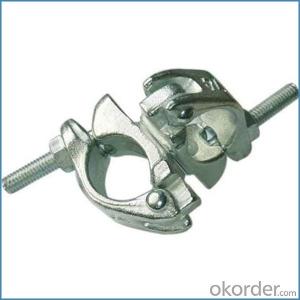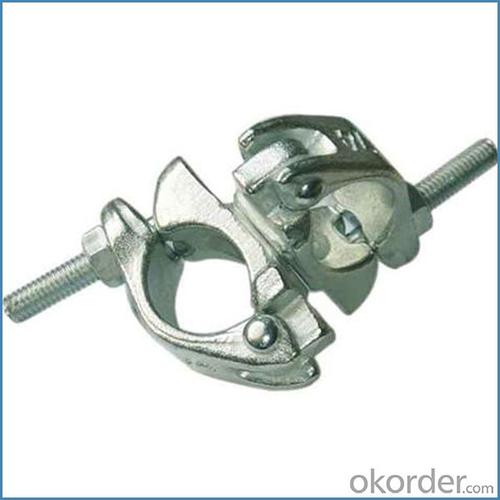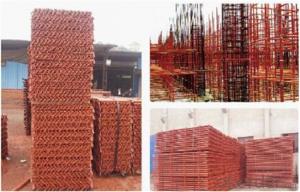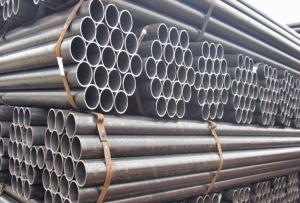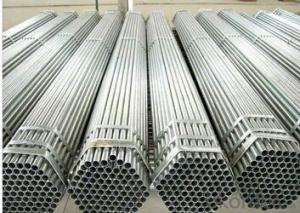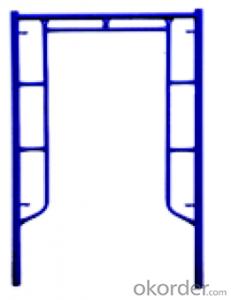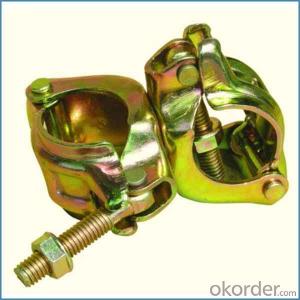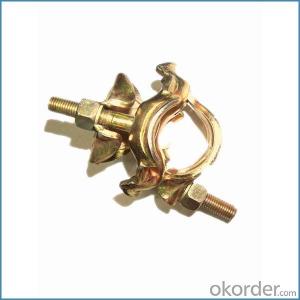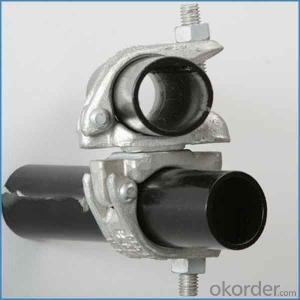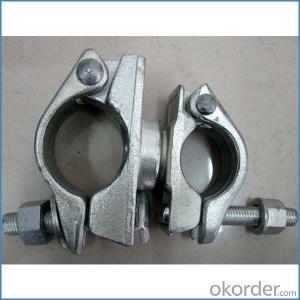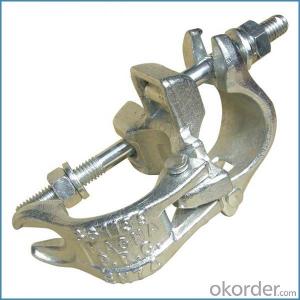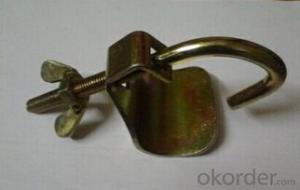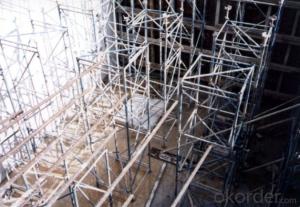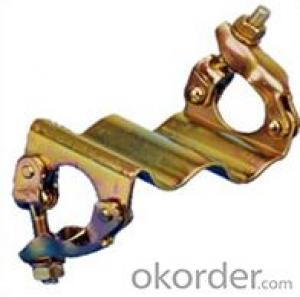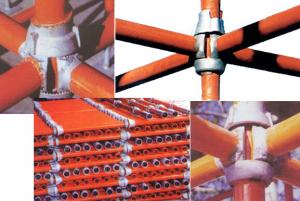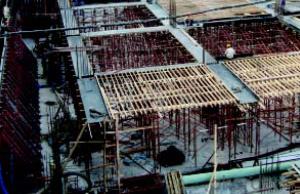British Type for Sale Swivel Coupler British Type for Sale
- Loading Port:
- Tianjin
- Payment Terms:
- TT OR LC
- Min Order Qty:
- 1000 kg
- Supply Capability:
- 100000 kg/month
OKorder Service Pledge
OKorder Financial Service
You Might Also Like
British Type for Sale Swivel Coupler British Type for Sale
Description
1.The scaffolding coupler is always used to connect the steel pipe as scaffolding system.
2.The often used coupler is swivel coupler and righ angle coupler .
3.We can provide types of scaffolding coupler according to your requirement.
4.Couoler can fix the 48.3mm scaffolding steel pipe tightly and make the whole scaffolding system more steadily.
5.Material:Q235 steel
6.Overall Size:48.3mm*48.3mm
7.Surface Finish: Galvanized/ Painted
8.Standard:BS1139,EN74
9.Package:25pcs/bag
10.Manufactuering as per customer requirements
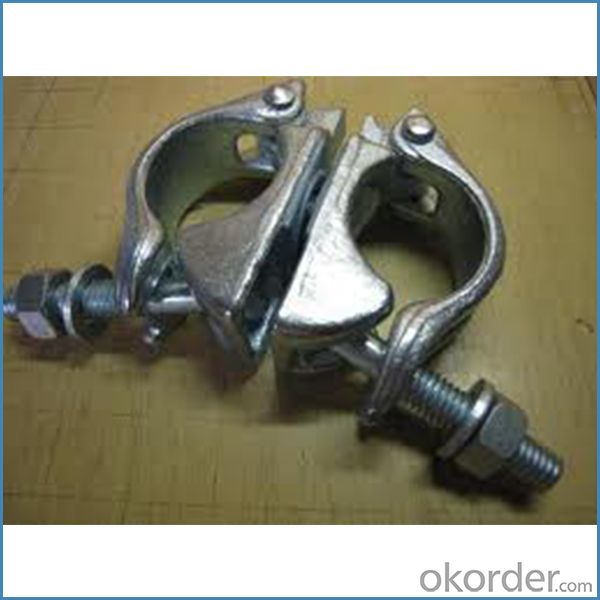
Feature
(1)Excellent Anti-Breaking—Cold Pressed Steel
(2)Outstanding Resistance Deformation
(3)Strong Anti-Dropping Ability
(4)Longtime USe
(5)Qualtity Guaranteed
(6)OEM Service
Photo
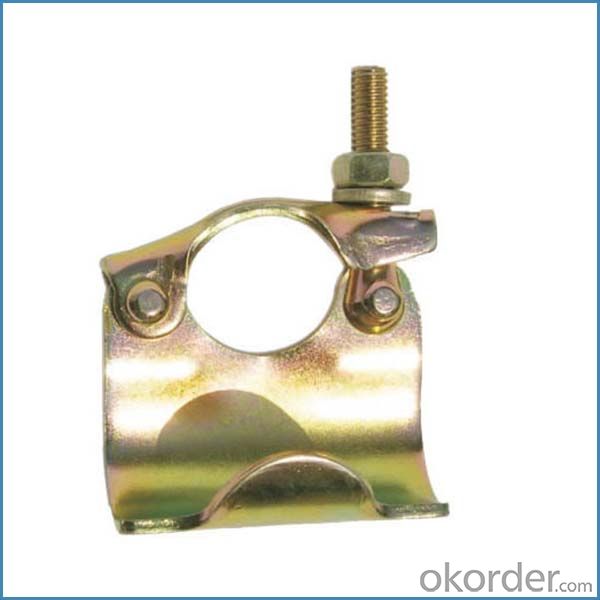
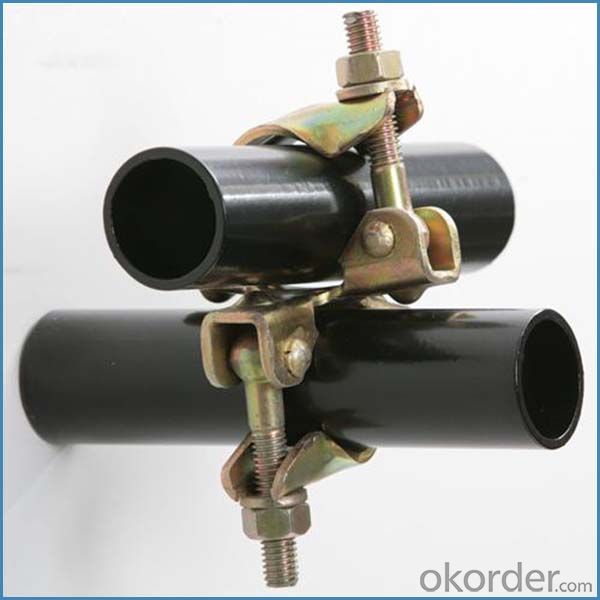
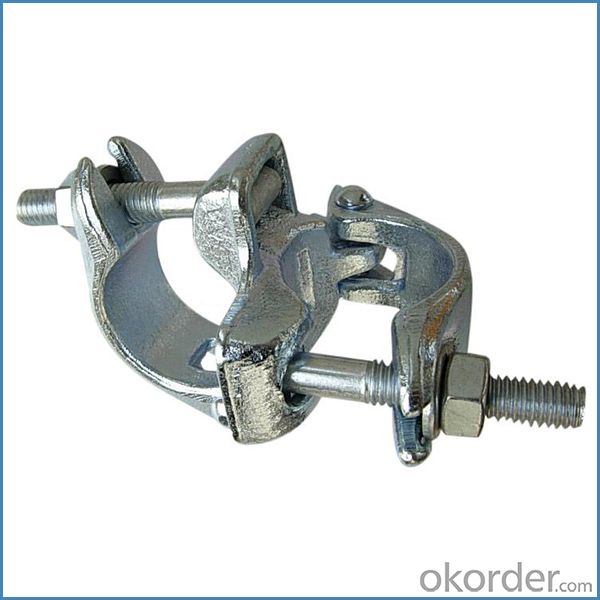
Parameter
| Material | Q235,345steel |
| Size | 48.3mm*48.3mm |
| Surface finish | Galvanized |
| Weight | 1.1kg around |
| Standard | BS1139,EN74 |
| Package | 25pcs/bag,steel pallet |
| Manufacture | As per customer requirement |
| Market | Africa, South America, the Middle East and Asia |
FAQ
Q: Are you a factory or trading company?
We are a state-owned corporation in China,dealing with various kinds of building materials.We have our holding subsidiaries.
Q: Where is your factory located? How can I visit there?
Our factory is located all around China.
Q: Can I get some samples?
Sample is free, customer only pay freight for the first time.
Q: Delivery?
10-30days. (5-15 containers)
Any question,feel free to contact us.
- Q: What are the typical sizes and dimensions of steel tube couplers for scaffolding?
- The typical sizes and dimensions of steel tube couplers for scaffolding vary depending on the specific requirements of the project. However, commonly used sizes include 48.3mm outside diameter and 4mm wall thickness for the main tubes, and 48.6mm outside diameter and 3.2mm wall thickness for the couplers. These dimensions ensure a secure and sturdy connection between the scaffolding tubes, providing stability and safety.
- Q: Hi everyone, I'll keep it simple - I'm in a place with very high (25-30 foot) ceilings and therefore want to build a partial first floor to maximise use of space. Kind of an all-the-way-round mezzanine, open in the centre.However, I don't own the porperty and expect to be there 2-3 years, so wanted the cheapest solution possible, and not necessarily permanent.It's been suggested to me that a scaffolding frame might be the answer, on which I can put platforms, build stud walls etc. just as I would any normal floor, rather than going to the trouble and expense of building load-bearing wooden stud walls on the ground floor and building on top.Anyone got any experience of this / knows the pros and cons? Particularly wondering about price comparisons (for both bvuying and long-term hiring) and the potential for what I could build on my first floor (what the scaffolding can take...)Thanks! I'm in London (UK). Remember - temporary, cheap, and load-bearing
- I agree with both 1 and 2, and certainly the property owner should be consulted. Much like Vacation cabin designs with a loft area, surrounding a first floor open to view from above, either choice would be labor intensive for a rental, BUT,,, the Landlord, might subscribe to the idea, if it was constructed as a decent, permanent addition. Properly constructed using Wooden supports, IE: 6 x 6, and floor joists, with stairs/ladder, the balance of the second level would be better supported, but more permanent. The Wood construction would also allow more OPEN first level floor/ movement space. Scaffolding will not, given it's support structure. Certainly a valid idea, and if you have the skills, worth pursuing, if you also have permission to do so. If you approach this properly, consulting the owner, you might not only get an OK, but perhaps negotiate some financial aid in the job. Steven Wolf just my two sense
- Q: Can steel tube couplers be used for temporary shoring or formwork support?
- Yes, steel tube couplers can be used for temporary shoring or formwork support. They provide a reliable and secure connection between steel tubes, allowing for the construction of temporary structures such as scaffolding or formwork support systems. The couplers ensure stability and strength, making them suitable for various temporary shoring or formwork applications.
- Q: Building construction bowl button steel pipe scaffolding and fastener scaffolding which cost high
- XPS Extruded polystyrene board: polystyrene is used as raw material plus a simple toilet bowl 丿 stagnation on the lack of other raw materials and fire protection agent, by heating and mixing at the same time into the catalyst, and then squeeze the molding of rigid foam The EPS expansion polystyrene board: is a volatile liquid blowing agent containing polystyrene (eps) beads, preheated by heating after the mold in the mold, with fine closed-cell structure characteristics
- Q: How do steel tube couplers ensure the stability and safety of scaffolding?
- Steel tube couplers ensure the stability and safety of scaffolding by securely connecting the steel tubes together, creating a strong and rigid structure. These couplers are designed to provide a tight and reliable connection, preventing any movement or displacement of the tubes during construction activities. This ensures that the scaffolding remains stable and can support the weight of workers and equipment without the risk of collapsing or shifting. Additionally, the use of steel tube couplers eliminates the need for welding or drilling, which can weaken the structure and compromise its safety.
- Q: Are there any specific guidelines for the safe use of steel tube couplers in scaffolding near electrical or hazardous areas?
- Yes, there are specific guidelines for the safe use of steel tube couplers in scaffolding near electrical or hazardous areas. These guidelines typically include ensuring proper insulation and grounding of the scaffolding, maintaining a safe distance from electrical equipment, and using non-conductive materials when necessary. It is crucial to follow these guidelines to minimize the risk of electrical accidents and ensure the safety of workers in such areas.
- Q: Can steel tube couplers be used in high-load scaffolding applications?
- In high-load scaffolding applications, steel tube couplers can be utilized. These couplers have been specifically designed to securely connect steel tubes in scaffolding systems, guaranteeing a reliable connection. Constructed from high-strength steel, these couplers have the ability to withstand substantial loads, thus providing stability to the scaffolding structure. Their usage is prevalent in construction and industrial environments that necessitate high-load capacities. Nevertheless, it is imperative to adhere to the manufacturer's guidelines and industry standards when installing and using these couplers to ensure safety and prevent any accidents or failures. Additionally, regular inspections and maintenance of the scaffolding system are crucial to uphold its integrity and ensure safe utilization in high-load applications.
- Q: Are there any specific guidelines for the safe use of steel tube couplers in scaffolding near overhead cranes or lifting equipment?
- Yes, there are specific guidelines for the safe use of steel tube couplers in scaffolding near overhead cranes or lifting equipment. These guidelines typically include ensuring that the scaffolding is designed and installed by competent professionals, maintaining a safe distance between the scaffolding and the overhead cranes or lifting equipment, regularly inspecting the couplers and scaffolding for any signs of damage or wear, and following proper procedures for securing the scaffolding to prevent accidents or collapse. It is important to consult local regulations and industry standards for more specific guidelines that may apply to the particular location and equipment being used.
- Q: How do steel tube couplers connect different scaffolding tubes?
- Steel tube couplers are a type of mechanical device that is used to connect different scaffolding tubes together. These couplers are specifically designed to securely join two or more tubes, creating a stable and rigid structure for scaffolding systems. The process of connecting steel tubes using couplers is relatively straightforward. Each end of the tube is inserted into the coupler, which typically consists of two halves that are bolted or tightened together. The coupler has a series of teeth or gripping mechanisms that securely hold onto the tube, preventing it from slipping or coming loose. Once the tubes are securely inserted into the couplers, they are typically tightened using a wrench or other similar tool. This ensures that the connection is strong and stable, making the scaffolding safe for workers to use. The tightness of the connection can be adjusted as needed, depending on the specific requirements of the scaffolding structure. Steel tube couplers are a preferred method of connecting scaffolding tubes due to their strength, durability, and ease of use. They provide a reliable and efficient way to assemble scaffolding systems quickly and securely. Additionally, they allow for easy disassembly and reconfiguration of the scaffolding as needed.
- Q: How do you dismantle scaffolding with steel tube couplers?
- To dismantle scaffolding with steel tube couplers, you need to follow a systematic approach to ensure safety and efficiency. Here is a step-by-step guide on how to do it: 1. Gather the necessary tools and equipment: Before starting the dismantling process, make sure you have all the required tools and equipment. These may include a wrench, hammer, pry bar, safety gloves, and safety goggles. 2. Assess the stability: Before dismantling the scaffolding, assess its stability. Ensure that it is properly secured and there are no loose or damaged components. If any part of the scaffolding seems unstable or unsafe, rectify the issue before proceeding further. 3. Begin at the top: Start the dismantling process from the top of the scaffolding. Remove any planks or platforms that are secured to the scaffold structure. This will allow you better access to the steel tube couplers. 4. Loosen the couplers: Using a wrench, loosen the bolts on the steel tube couplers. Turn them counterclockwise to release the tension. If any bolts are too tight or rusted, you may need to use a hammer or pry bar to gently tap or loosen them. 5. Remove the couplers: Once the bolts are loosened, carefully remove the steel tube couplers one by one. When removing the couplers, make sure to support the connected tubes to prevent them from falling. 6. Disassemble the tubes: After removing the couplers, disassemble the tubes by pulling them apart. If any tubes are stuck, you can use a rubber mallet or pry bar to separate them. Ensure that you do this step cautiously to avoid any accidents. 7. Secure and store the components: As you dismantle the scaffolding, ensure that all components are stored safely and securely. Properly organize and stack the tubes, couplers, and other parts to prevent any damage and make it easier for future use. 8. Repeat the process: Continue the dismantling process by moving down the scaffolding structure, removing one section at a time. Always maintain a safe working height and ensure that all connections are properly secured before moving to the next section. 9. Clean up and inspection: Once the scaffolding is completely dismantled, clean up the area and inspect all components for any signs of damage or wear. Discard any damaged or non-functional parts and replace them before reusing the scaffolding. Remember, safety should always be the top priority when dismantling scaffolding. If you are unsure or uncomfortable with the process, it is always recommended to seek assistance from a professional or experienced individual.
Send your message to us
British Type for Sale Swivel Coupler British Type for Sale
- Loading Port:
- Tianjin
- Payment Terms:
- TT OR LC
- Min Order Qty:
- 1000 kg
- Supply Capability:
- 100000 kg/month
OKorder Service Pledge
OKorder Financial Service
Similar products
Hot products
Hot Searches
Related keywords
